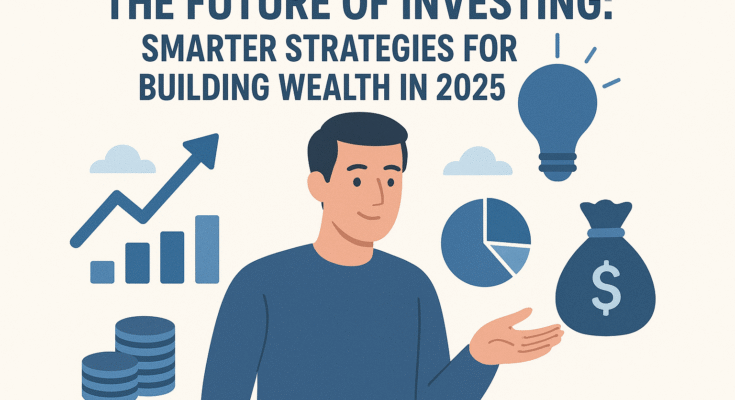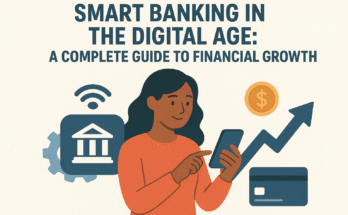Money has always been more than a medium of exchange. It represents security, opportunity, and freedom. For centuries, people have sought ways to grow their wealth, from trading land and gold to buying company shares and real estate. But the rules of investing have never been as dynamic as they are today.
In 2025, we’re entering a new era where technology, globalization, and changing lifestyles are reshaping how people think about money. Investing is no longer reserved for professionals on Wall Street. With digital tools, robo-advisors, and fractional ownership, anyone can become an investor from their phone. But this accessibility also brings challenges: greater competition, shorter market cycles, and more noise than ever before.
This guide explores unique, forward-looking strategies and opportunities that define the future of investing. Instead of focusing only on old-school advice, we’ll look at how to build wealth with methods designed for today’s world.
Why Investing Has Changed Forever
A generation ago, investing was straightforward. People bought stocks, bonds, or real estate and held them for decades. But now, the landscape has shifted dramatically. Technology allows trades to happen in milliseconds, global markets are interconnected, and new asset classes are emerging rapidly.
There are three key forces driving this transformation:
- Technology – Artificial intelligence, automation, and blockchain are changing how assets are created, traded, and managed. Algorithms can now analyze markets faster than any human could.
- Accessibility – Mobile platforms and micro-investing apps allow individuals to start with just a few dollars. Ownership is no longer limited to the wealthy.
- Mindset Shifts – Younger generations value flexibility and experiences. Instead of tying up wealth only in property or retirement funds, they are diversifying into unconventional investments like digital assets, peer-to-peer lending, and even collectibles.
These changes mean that the strategies that worked in the past may not guarantee success in the future. A new approach—adaptive, diversified, and forward-looking—is essential.
Smarter Approaches to Traditional Investments
Traditional investments like stocks, bonds, and real estate are still powerful wealth-building tools. But to succeed today, they need smarter approaches than simply buying and holding.
Smarter Stock Investing
Instead of trying to pick the “next big company,” investors are increasingly focusing on thematic investing. This involves identifying long-term global trends—such as renewable energy, biotechnology, or artificial intelligence—and investing in companies that drive those sectors.
For example, while individual stock picking can be risky, investing in an exchange-traded fund (ETF) focused on clean energy or healthcare innovation spreads risk across dozens of companies while aligning with future growth.
Bonds with a Twist
Bonds are considered conservative, but they are evolving too. In 2025, green bonds—which fund environmentally friendly projects—are gaining popularity. These provide investors with steady returns while supporting sustainability goals. For those seeking higher yields, emerging market bonds are another growing option, though they require careful risk management.
Real Estate Beyond Ownership
Owning property is no longer the only way to invest in real estate. New platforms allow fractional ownership of rental properties, letting investors purchase a share of income-generating buildings. Real estate investment trusts (REITs) also remain popular, providing exposure to commercial or residential markets without the hassle of direct ownership.
New Frontiers in Investing
The most exciting opportunities of the decade lie outside traditional markets. These new frontiers are shaping the next wave of wealth creation.
Digital Assets and Blockchain
Cryptocurrencies may have been volatile, but blockchain technology has created new forms of investment beyond Bitcoin. Tokenized assets—where real estate, art, or even music royalties are represented digitally—allow investors to own fractions of high-value items. This trend lowers barriers and creates liquidity in markets that were once inaccessible.
Alternative Assets
We’re seeing a rise in investments like peer-to-peer lending, where individuals lend directly to borrowers via platforms, earning interest without banks as intermediaries. Collectibles—such as rare sneakers, watches, and even digital art—are also emerging as legitimate asset classes. These markets thrive on scarcity and cultural value.
Sustainable and Impact Investing
More people now want their money to align with their values. Impact investing focuses on companies that drive positive social or environmental change while delivering profits. This dual focus on returns and responsibility is becoming mainstream, as investors demand both wealth and purpose.
Building a Future-Proof Investment Strategy
With so many options available, the real challenge isn’t finding investments—it’s building a strategy that withstands uncertainty. The most successful investors in 2025 will adopt a future-proof approach built on three principles:
- Diversification Across Classes – Combining traditional assets like stocks and real estate with modern ones like digital assets and sustainable funds reduces reliance on any single market.
- Adaptability – Markets move faster than ever. Having flexible strategies that can adjust to changing conditions is crucial.
- Long-Term Vision – While day trading and speculative hype attract attention, true wealth still comes from patience and compounding over years, not weeks.
A practical example of this might be allocating a portfolio as follows:
- 40% in diversified stocks and ETFs
- 20% in real estate or REITs
- 20% in bonds and fixed income
- 10% in digital or alternative assets
- 10% in cash or liquid reserves
This balance provides exposure to growth while maintaining stability.
The Psychology of Investing
One often-overlooked aspect of investing is psychology. Markets are driven not only by numbers but also by human behavior—fear, greed, and herd mentality. Recognizing and managing these emotions is critical.
Many investors lose money because they panic-sell during downturns or chase “hot” assets during bubbles. Successful investors understand that volatility is normal. Instead of reacting emotionally, they rely on data, research, and disciplined strategies.
In 2025, tools like robo-advisors and automated investing platforms can help remove some of this emotional bias by sticking to algorithms and rebalancing portfolios automatically. But at the end of the day, cultivating patience and discipline remains the most valuable skill any investor can develop.
Mistakes to Avoid in Modern Investing
Every investor makes mistakes at some point, but some errors can be especially costly. Avoiding these common pitfalls is just as important as finding the right opportunities.
Chasing Hype
Markets are filled with trends that come and go. Whether it’s a sudden stock boom, a meme coin, or a viral startup, chasing hype rarely ends well. By the time most people hear about a “hot” investment, insiders may already be exiting. Successful investors resist the temptation to jump into what’s popular and instead focus on long-term fundamentals.
Ignoring Risk Management
It’s easy to get excited about potential returns, but ignoring risks can lead to devastating losses. Risk management means diversifying investments, setting stop-loss levels, and never putting more money into a single asset than you can afford to lose. Even the safest-looking opportunities carry risk, and being prepared for downturns is key.
Short-Term Thinking
Wealth is rarely built overnight. Day trading, speculative flipping, and get-rich-quick schemes may sound appealing, but they usually favor platforms and brokers more than investors. A long-term horizon, paired with consistent contributions, is far more effective than short-term gambling.
Lack of Research
Investing blindly—whether in stocks, bonds, or alternative assets—often leads to disappointment. Due diligence is essential. Reading financial reports, understanding market trends, and analyzing competitive landscapes can make the difference between success and failure.
Emotional Decisions
Perhaps the biggest mistake is letting fear or greed control decisions. Selling during a market dip or buying excessively during a boom usually results in regret. Having a plan and sticking to it helps counter emotional reactions.
A Step-by-Step Guide to Starting as an Investor
For beginners or even seasoned savers who haven’t yet invested seriously, the process can seem overwhelming. Here’s a simple roadmap to get started in 2025.
Step 1: Define Your Goals
Why are you investing? Retirement, a down payment on a home, or simply financial independence? Goals determine both time horizon and risk tolerance. For example, someone saving for a house in five years may choose safer investments, while someone planning for retirement in 30 years can handle more risk.
Step 2: Assess Your Risk Tolerance
Every individual has a different comfort level with risk. Some can handle volatility in exchange for higher potential returns, while others prefer stability. Online tools and robo-advisors can help determine your profile.
Step 3: Build an Emergency Fund First
Before putting money into long-term investments, it’s crucial to have at least three to six months of living expenses saved in a liquid account. This prevents having to sell investments during emergencies.
Step 4: Choose an Investment Platform
Modern investors have countless choices, from traditional brokerage firms to mobile apps. When selecting a platform, look for factors such as fees, ease of use, available assets, and security. For those who prefer automation, robo-advisors offer low-cost, AI-driven portfolio management.
Step 5: Start Small but Stay Consistent
The best way to begin is by starting with manageable amounts. Thanks to fractional investing, even $50 can buy into a diversified ETF. The key is consistency—investing a fixed amount regularly rather than trying to time the market.
Step 6: Diversify Across Assets
Rather than putting all funds into a single stock or property, spread investments across asset classes. This balances risks and provides stability. A mix of equities, bonds, real estate, and alternative assets works for most investors.
Step 7: Review and Rebalance Regularly
Markets shift, and so do personal circumstances. Reviewing portfolios every few months and rebalancing allocations ensures alignment with goals and risk tolerance. For example, if stocks rise too much and dominate a portfolio, shifting some funds back into bonds or real estate may restore balance.
Long-Term Wealth-Building Habits
Wealth isn’t built only on good investments—it also comes from good financial habits.
Consistency Over Perfection
Investors often spend too much time worrying about timing. In reality, regular contributions—month after month—outperform sporadic, large investments. Consistency harnesses the power of compounding.
Living Below Means
No investment strategy can outpace reckless spending. Keeping expenses controlled ensures more capital is available for investing. This discipline compounds over time.
Reinvesting Returns
Instead of withdrawing profits immediately, reinvesting dividends, interest, and rental income accelerates growth. Compounding turns modest returns into substantial wealth over decades.
Lifelong Learning
Markets evolve constantly. Staying informed about economic trends, technological changes, and new opportunities ensures investors adapt. Reading books, following expert analyses, and experimenting with new platforms helps sharpen skills.
Patience as a Superpower
Perhaps the most underrated habit is patience. Many legendary investors credit their success not to constant buying and selling but to holding quality assets for years. Allowing investments time to grow is often the most powerful strategy of all.
Technology and the Future of Investing
Technology is no longer just a tool—it’s becoming the backbone of investing itself.
Artificial Intelligence in Finance
AI-driven platforms can analyze thousands of data points in real-time, spotting opportunities faster than human traders. Robo-advisors already use AI to build and rebalance portfolios, making personalized wealth management accessible to everyone.
Blockchain and Tokenization
Blockchain technology is creating digital marketplaces where ownership is transparent, secure, and efficient. Tokenization allows high-value assets—like real estate, fine art, or even music royalties—to be split into smaller shares. This democratizes access, enabling investors to participate in markets previously out of reach.
Automated Savings and Micro-Investing
Apps now link directly to bank accounts, automatically rounding up purchases and investing spare change. While small individually, these micro-investments add up significantly over years.
Predictive Analytics
Advanced algorithms use predictive analytics to forecast market behavior. While not foolproof, these tools help investors make data-driven decisions rather than relying solely on intuition.
The Future of Responsible Investing
Beyond profits, the investment world is embracing responsibility. Investors increasingly want portfolios that align with environmental and social values. This shift isn’t just ethical—it’s strategic. Companies focused on sustainability often adapt better to regulatory changes and consumer expectations.
- Environmental Investing: Funding renewable energy, green infrastructure, and carbon reduction.
- Social Impact: Supporting businesses that promote education, healthcare, and fair labor practices.
- Governance: Favoring companies with transparent, ethical leadership.
This trend is expected to accelerate, making responsible investing both a moral and financially wise choice.
Conclusion: Building Wealth That Lasts
The future of investing isn’t about chasing the latest trend or taking extreme risks. It’s about building strategies that adapt, diversify, and last.
Smart investors in 2025 will:
- Avoid hype and focus on fundamentals.
- Build portfolios that mix traditional and modern assets.
- Use technology as a tool, not a crutch.
- Cultivate patience, discipline, and consistency.
- Align investments with both financial and personal values.
Wealth is not built in weeks or months but through years of disciplined choices. The earlier one starts, the more powerful compounding becomes. But regardless of age or income level, the best time to invest wisely is now.
Investing is not just about making money—it’s about creating a secure, flexible future where financial independence opens doors to new opportunities. By following smarter strategies and embracing the future of finance, anyone can begin building lasting wealth today.


